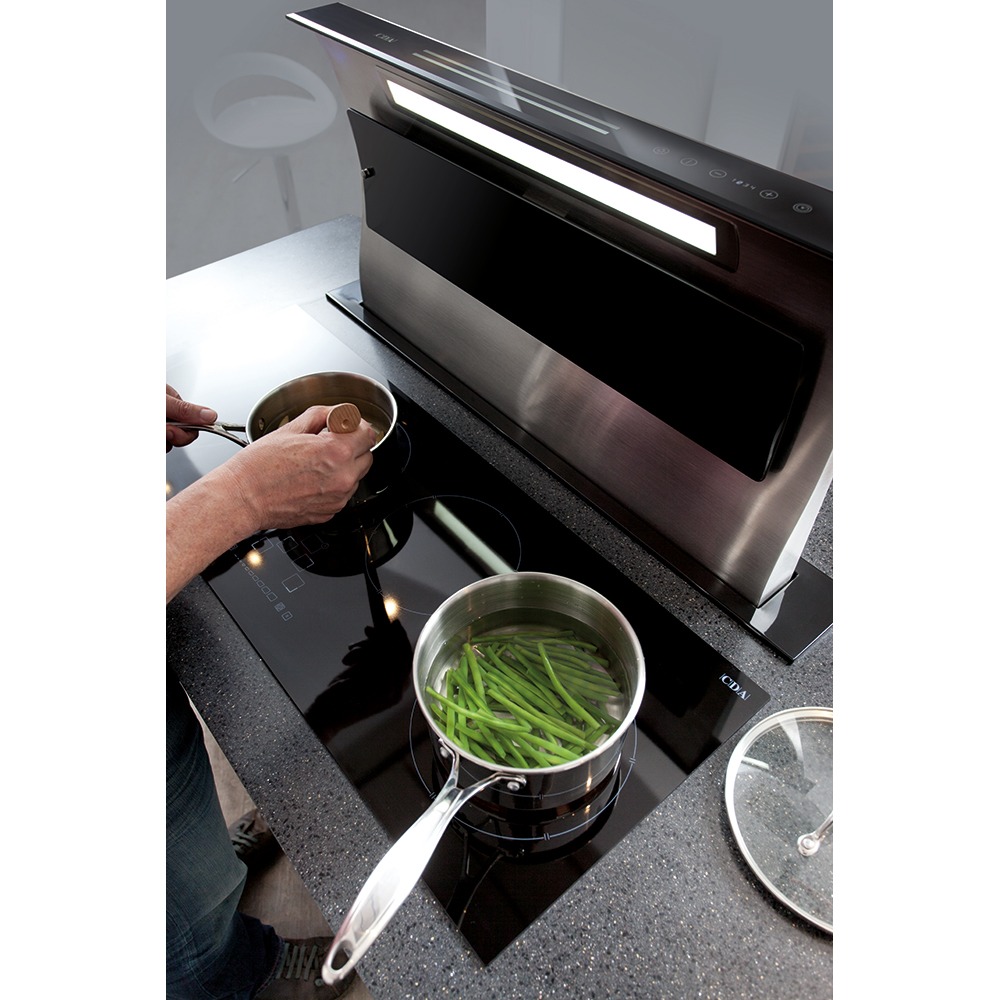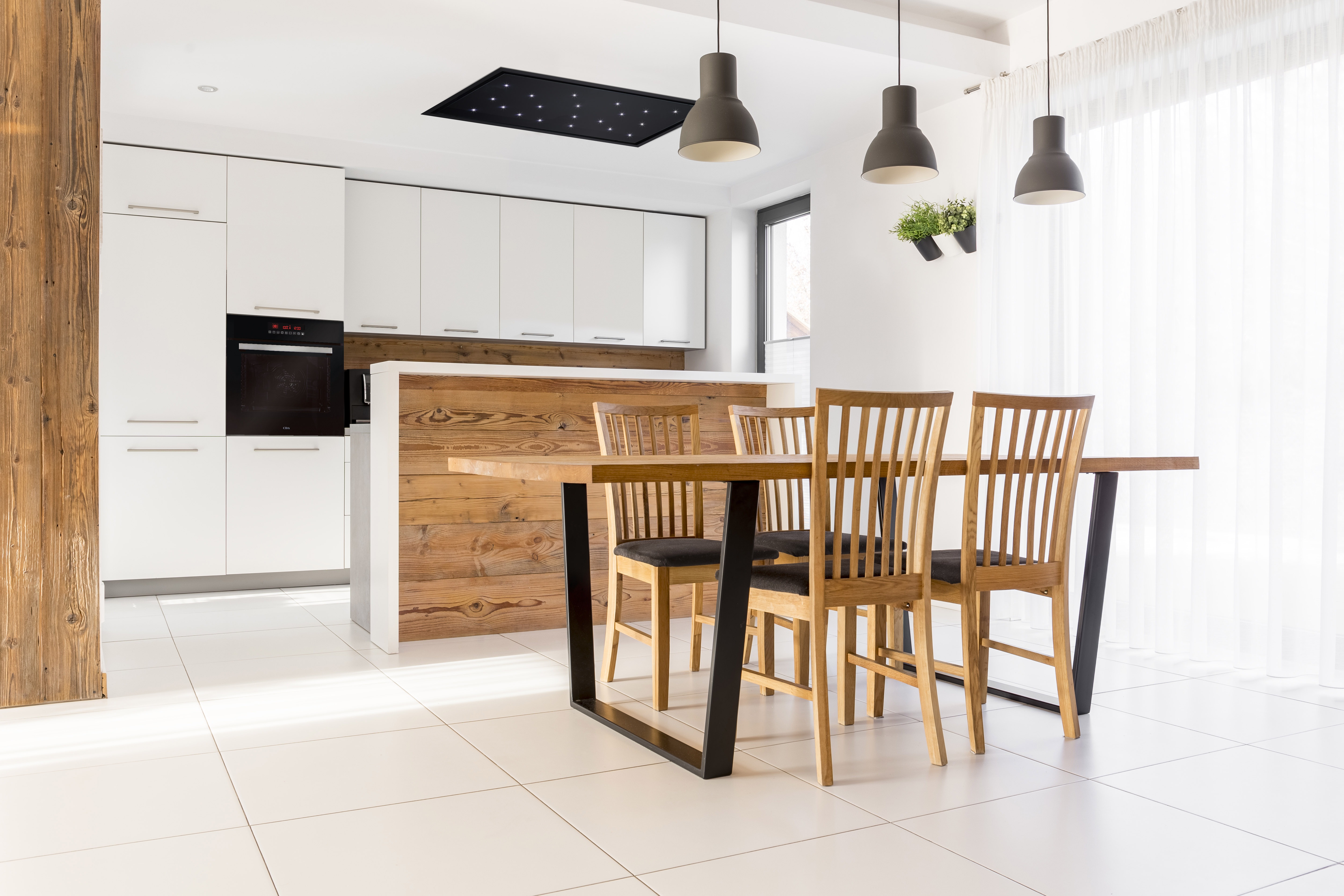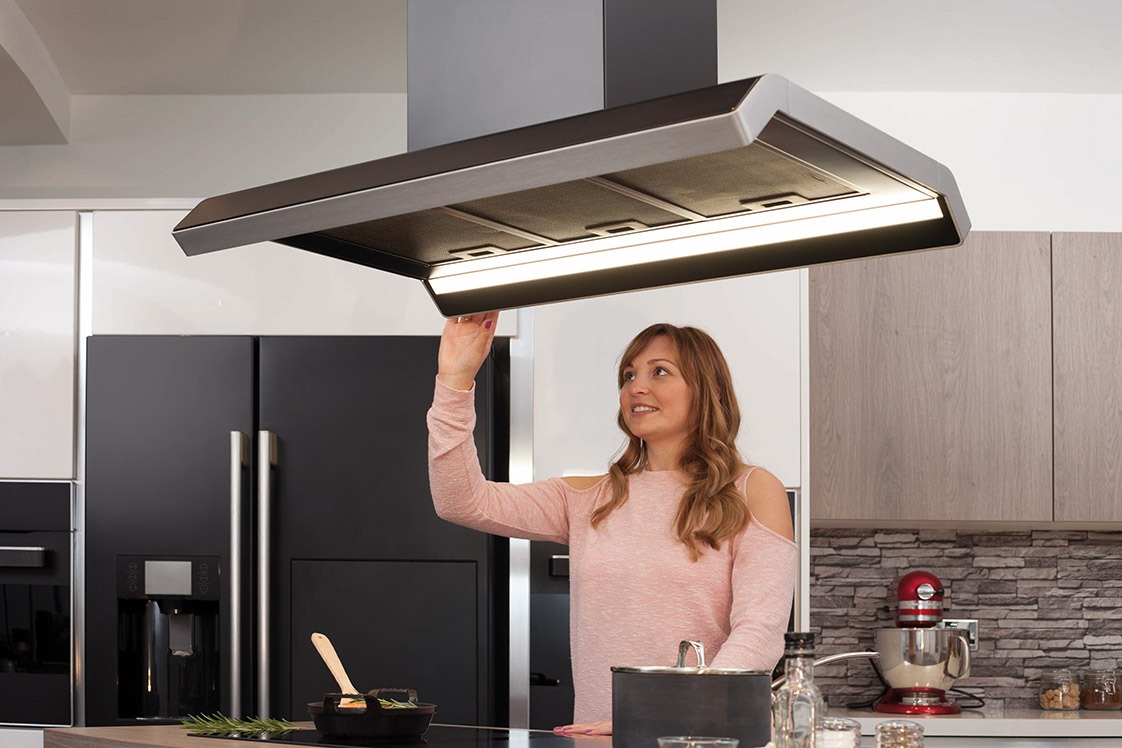Downdraft, Ceiling or Island Extractor – Which is Best?
Island extractor fans are ideal for eliminating moisture, odours, heat and smoke that may occur when cooking. An extractor fan ventilates a room by pulling particulates from the air. The fan then pushes that air up through a vent kit which is usually fed through a wall, so the air escapes outside. If you opt for a recirculating extractor fan, the air is sucked up into a funnel and pushed through charcoal filters that then purifies the air. The purified air is then forced back into the room – so, no need for outside venting.There are three main types of extractor fans you can use if your hob is on an island:
All three cooker hood types serve the same purpose – your kitchen will be well ventilated from moisture, smoke and smells, however aesthetically and functionally, they’re all very different. Let’s take a look at the difference between them…
What are the differences between downdraft, ceiling and island extractors?
Essentially, all of the extractors do the same thing, however, there are a few things to consider before you make a purchase. How often do you like to cook and how intense is the cooking you do? Do you want your cooker hood to feature in the design of your kitchen? How high are your ceilings? The answers to these questions will determine which extractor is right for you and your lifestyle.Downdraft Extractors

- A downdraft extractor fan gives you a clear space. They’re usually installed underneath your countertop, and will rise up directly next to your hob when in use.
- Downdraft extractors sit flush with your work surface when not in use, making them the perfect choice if you want to create a minimalist space.
- Downdrafts are very sleek and minimal in design when not in use, however, you must ensure that you have enough space beneath your worktop to accommodate it.
- They’re usually mechanically controlled with touch buttons, meaning they’re a lot smarter than other extractors.
- There are limitations for placement when it comes to the proximity to your hob for safety reasons, you must ensure you have sufficient worktop space if you wish to install one.
- When compared to other extractors such as kitchen island extractor fans and flush ceiling extractor hoods, downdrafts are much quieter. Your average extractor fan has a sound level similar to that of a vacuum cleaner. At its highest level, a downdraft extractor fan’s sound level is equivalent to the sound of cooking meat in a frying pan.
How do downdraft extractors work?
Downdraft extractors are usually placed within a safe distance to the back of your hob. They blend in with the countertop when not in use and then will rise up when needed, returning to their flush position when the job is done.How does a downdraft ventilation system work?
Typically, downdrafts are recirculated although they can be vented to the outside. To vent a downdraft extractor to the outside, you’ll have to go down through the floor if your island/breakfast bar isn’t adjacent to a wall which may mean installation costs are higher.As mentioned above, downdrafts are best for recirculation. Within the unit, you’ll find charcoal filters which remove grease, smoke and smells from the air before pushing it back into your kitchen.
Ceiling Extractors

- Ceiling extractor fans can be more or less invisible. Especially if you purchase one that sits flush to your ceiling. They’re designed to blend into the ceiling and surrounding area, instead of it standing out like a designer island cooker hood for example.
- A ceiling extractor hood is very powerful. Perfect for those who have large gas hobs or do more intense cooking!
- Due to the fact ceiling extractors are flush to the ceiling, they’re usually remote controlled.
- If you want your extractor to stand out a little, you can achieve this with ceiling hoods. Although the majority are created to blend in, you can find many sleek and stylish designs that protrude out from the ceiling. They can be great to look at without being too eye-catching or offensive.
- Ceiling extractors are used over an island but can also be used over a hob that sits against a wall.
- A ceiling extractor hood is in prime position to be vented effectively without the use of additional “filler” material. The vent will feed through the ceiling cavity and directly into the extractor fan, making them a much simpler option to your standard cooker hood.
- Although a ceiling extractor is powerful, you will get more noise than a downdraft hood. The power brings the noise. If you’re installing your extractor primarily for aesthetic reasons, a downdraft is more suited.
How do ceiling extractors work?
Ceiling extractor fans often sit flush against the ceiling, directly above the hob. They’re usually vented to the outside through the ceiling cavity to an external wall. They can also be “boxed in”, essentially creating a false ceiling to house the extractor and the ventilation pipes, creating a new dimension within your kitchen. However, this may not be a suitable option if you have low ceilings.Ceiling hoods will often house a number of spotlights too, illuminating your workspace more effectively than other extractor hoods.
Island Extractors

- They’re designed to a complete 360-degree specification, unlike your traditional chimney cooker hoods. As Island cooker hoods are placed in the middle of a room, you want the full design of the hood to be the same all the way around. Some Island extractor hoods come in a chimney style, while others hang from the ceiling.
- Island extractors are designed to be a lot bigger than your normal ceiling hoods. This is because a kitchen island is usually only installed in larger kitchens. In turn, the island extractors are larger in order to keep large open-plan kitchens odour, smoke and grease-free.
- In-ceiling extractor fans hang directly from the ceiling of your kitchen. You must ensure that you have enough space between the ceiling and your hob before purchasing an island extractor.
- Island extractors are beautiful statement pieces. If you have an open-plan kitchen and dining area, installing an island extractor will create a great break between the two rooms if you want to keep the spaces open but separate, at the same time.
- Designer island extractor hoods are great to look at. If you want an eye-catching ventilation system that sits comfortably within the design and style of your kitchen, a designer extractor is for you.
How do island extractor fans work?
Island extractors are hung from the ceiling and can be vented through the ceiling to the nearest external wall. Island extractor fans can also be recirculated by using charcoal filters.A recirculated island extractor will pull the smoke, odour and grease from the hob, clean it through the charcoal filters and push it back out through the top of the unit.
Which extractor hood is best for low ceilings?
The best extractor hood for low ceilings is a ceiling cooker hood or a downdraft cooker hood. Island extractor hoods are too large for low ceilings and may not leave a safe distance between itself and the hob.Ceiling hoods sit flush to the ceiling in your kitchen so you can have both a gas or induction hob and the cooker hood won’t be compromised. The downside to a ceiling hood is that the air is allowed to circulate more than a downdraft extractor due to the distance between the ceiling and the hob. However, if you have a low ceiling, the extractor will sit closer to the hob and therefore minimises this distance. A ceiling extractor hood works great on low ceilings.
A downdraft hood sits closer to your hob than any other type of extractor. If you have limited ceiling height, installing a downdraft is a perfect choice. Odour and smoke will be instantly sucked into the extractor as soon as it escapes from the pan. However, you must be careful with the placement during your downdraft extractor installation. If you have a gas hob and you position the downdraft too close, the flames will either pull to one side or worse, get sucked in by the fan.
Which type of hood is the quietest?
The quietest hood is the downdraft extractor. The noise level is related to the extraction rate, so whilst a downdraft is quiet, it doesn’t have as much pull as an extractor fan on the kitchen ceiling. Although, this doesn’t make a tonne of difference with a downdraft as it’s positioned incredibly close to the hob unlike a ceiling or island extractor.Ceiling fans have the best extraction rate and are therefore louder. As an example, our EVX101 Ceiling Extractor has an extraction rate at first speed of 220 m3/hr and a noise level at first speed of 45 dBA. At intensive speed, the extraction rate is 750 m3/h, with a noise level speed of 70 dBA. However, a higher extraction rate doesn’t necessarily mean they do a more efficient job. It’s important to look into the extraction rate and noise level of your ceiling extractor fans for the kitchen before you make a purchase.
CDA ceiling extractor fans are super energy efficient, with ratings between A and C.
Do cooker hoods have to vent outside?
Cooker hoods do not have to vent outside. The air can also be recirculated. Depending on your needs for the cooker hood, we advise that you figure this out before purchasing as some island hoods are recirculation only.In order to find out whether you would require a vented hood or a recirculation hood, you need to decide on where the extractor is going, the type of hob that you’re using, how often you cook, if you have the space for a vent to the outside of your property, and the style that you’re after.
Do recirculating cooker hoods remove steam?
Recirculating cooker hoods do remove steam. By inserting charcoal and grease filters into your extractor, the steam will be removed when the air is pushed up into the filters. However, a vented cooker hood is much more efficient at removing steam.How often should you change cooker hood filters?
On average, your filters will need replacing every 4 to 6 months for maximum efficiency. The frequency at which you should change your cooker hood filters depends largely on the amount of cooking and the type of cooking that you do. If you often fry food at high temperatures, such as steak, then it’s likely that you’d need to replace your filters earlier than if you only use your hob to boil vegetables.What cooker hood do I need?
This largely comes down to personal preference. You need to consider the following:- Aesthetics
- Space required
- Cost
- Installation
- Performance
If you have an island hob, an island extractor, ceiling extractor or downdraft all work perfectly. An island extractor is quite bulky which is perfect for large open-plan kitchens and can be a great focal piece. If you want to reduce the number of appliances that you have on show then a ceiling or downdraft would be better as they are less conspicuous and can be “hidden away”. It’s also worth considering that a downdraft will take up cupboard space. This space is usually crucial for a kitchen island, as they don’t have much space to begin with. If cupboard space is needed, a ceiling extractor would be best suited.
There are pros and cons to all kitchen extractors. As mentioned before, it’s best to consider the advantages and disadvantages of all the types of extractors and eliminate them one-by-one before making your final decision.
——-
Have a question about kitchen extractors? Get in touch and we’ll be happy to talk you through what the CDA range has to offer.
